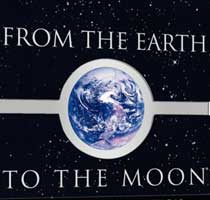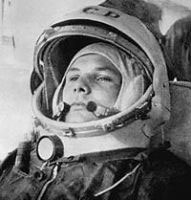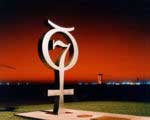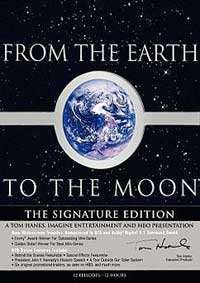From the earth to the moon《从地球到月球》精讲之一
影片对白

Speaker: There is historic news from behind the Iron Curtain. Man has traversed the reaches of outer space, and that man is a Communist. Soviet pilot Yury Gagarin in the spacecraft Vostok l successfully lifted off the face of the Earth flew his craft around the globe in approximately 90 minutes and landed safely in the Soviet Union. As with the flight of Sputnik four years ago this latest Russian achievement has caught those in the American space program by surprise. The seven American astronauts of the Mercury space program suddenly find themselvesjockeying for second place. It has been reported that either Gus Grissom, John Glenn or Alan B. Shepard will be the first to fly the one-man Mercury space capsule. Just when the flight will take place has been the subject of much speculation. Tonight President Kennedy is meeting with officials of the National Aeronautics and Space Administration to discuss not just why we are losing the space race but perhaps if it has already been lost.
Jerome Weisner: The Russian went into orbit.
James Webb: One orbit, yes.
Jerome Weisner: We can't even match that.
James Webb: Not yet.
Ted Sorenson: Gentlemen. President has been keeping up with your hearings before Congress and committees. For the purpose of tonight's meeting, we can dispense with small talk. He will want to know how we can catch the Russians or better yet, leapfrog them.
Hugh Dryden: We can put a man on the moon before the Russians. How about that? It'll take a concerted national effort. Somethingalong the lines of the Manhattan Project.
Ted Sorenson: How much would it cost?
Hugh Dryden: Somewhere between $10 billion and $20 billion.
David Bell: Pumping that much cash into the private sector could be popular.
Jerome Weisner: He will ask if there's anything we can do for less of the taxpayers' dollars.
Ted Sorenson: What if we put up a space laboratory of some kind?
Hugh Dryden: They'll beat us. If we get into a race with them over heavy lifting capabilities which is all that putting up a space station will demonstrate we're going to lose for at least the next five years.
David Bell: Hugh, were you as sure about this when you were working under Eisenhower?
Hugh Dryden: No, but the Soviets hadn't put a man in space then. Most assuredly, the moon is their ultimate objective.
David Bell: Red moon, huh? Who wants that hangin' over our heads?
Jerome Weisner: As head of the president's science advisory, I've gotta tell him that politics aside there's no reason to put a man on the moon. The only thing we'll get for our money is some rocks. So, put a probe up, scoop some out, bring 'em back and tour the world with them for propaganda purposes. You don't need to send a man a quarter of a million miles away to do that. And it sure as hell won't cost $20 billion.
James Webb: Well, certainly the president realizes that the moment a man steps on the moon will be a definitive one in the history of the world.
David Bell: Especially when he sticks Old Glory in it and salutes.
Ted Sorenson: He's ready for us. Can the president count on anything in the immediate future?
James Webb: Yes, the second of May. We'll have an American up on the second of May.
妙语佳句,活学活用
1. Iron Curtain
即“铁幕”。The boundary between Soviet-controlled eastern Europe and western Europe. The phrase was first used by Ethel Snowden, wife of a British Labour politician, in 1920, but was made famous by Winston Churchill, who said in Fulton, Missouri, in March 1946, ‘An iron curtain has descended across the Continent’. Hence the countries of the Soviet bloc were called ‘iron curtain countries’, especially by right-wingers.
2. Lift off
这个片语指的是“(火箭, 导弹等)发射, (直升飞机等)起飞”,例如:China’s first moon orbiter Chang’e I has been lift off successfully on October 24, 2007.
3. Sputnik
俄语,苏联人造地球卫星。
4. Jockey
Jokey 这里的意思是指“运用手段图谋某个职位或利益”,例如:John is jockeying for a promotion.
5. Small talk
意思是“Casual or trivial conversation, chitchat 闲聊”,例如:We stood around making small talk until the guest of honor arrived.
Small 这里指“不重要的谈话主题”,和那些严肃、重大的主题相对应。
6. Along the lines of
这个片语也写作on the lines of,意思是“大致相似,差不多”,例如:We told the architect we want a design along the lines of his own house but smaller.
7. Manhattan Project
是美国政府研制第一枚原子弹的计划,时间为从1942到1945年。 In 1939 US scientists urged Pres. Franklin D. Roosevelt to establish a program to study the potential military use of fission (核裂变), and $6,000 was appropriated. By 1942 the project was code-named (编号)Manhattan, after the site of Columbia University, where much of the early research was done. Research also was carried out at the University of California and the University of Chicago. In 1943 a laboratory to construct the bomb was established at Los Alamos, N.M., and staffed by scientists headed by J. Robert Oppenheimer. Production also was carried out at Oak Ridge, Tenn., and Hanford, Wash. The first bomb was exploded in a test at Alamogordo air base in southern New Mexico. By its end the project had cost some $2 billion and had involved 125,000 people.
8. Somewhere between $10 billion and $20 billion.
这是一句非常好用的口语表达,意思是“100亿到200亿美元之间吧”。当要表示“在……之间”时,我们就可以用Somewhere between 后面加上两个并列的事物,例如:somewhere between 1426 and 1435,1426年到1435年之间。
9. Private Sector
The total economy is composed of two sectors, the private sector and the public sector. 指的是社会经济中的“私营部分”。像航空航天,国家基础设施等这类关系社会公共利益的经济部分在美国一般是国营或者国家控股,而其他的都是私营。
10. Heavy lifting capabilities 指“载重能力”。
11. Old Glory
是美国人对自己国旗的爱称。
12. In the immediate future
意思是“在不久的将来”,和in the near future 差不多,例如:We'll be needing a new car in the near future.
文化面面观
Gagarin & Mercury space program
1. Yuri Alexeyevich Gagarin 加加林——人类进入太空第一人
(1934 - 1968), cosmonaut; first human to orbit Earth in a spacecraft.
 |
| Yuri Alexeyevich Gagarin |
The son of a carpenter on a collective farm, Yury Gagarin was born in the village of Klushino (克卢希诺镇集体农庄), Smolensk Province (斯摩棱斯克州). During World War II, facing the German invasion, his family evacuated to Gziatsk (格扎茨克now called Gagarin City). Gagarin briefly attended a trade school to learn foundry work, then entered a technical school. He joined the Saratov Flying Club in 1955 and learned to fly the Yak-18. Later that year, he was drafted and sent to the Orenburg Flying School (奥伦堡航空军事学校), where he trained in the MIG jet. Gagarin graduated November 7, 1957, four days after Sputnik 2 was launched. He married Valentina Goryacheva, a nursing student, the day he graduated.
Gagarin flew for two years as a fighter pilot (歼击机飞行员) above the Arctic Circle. In 1958 space officials recruited air force pilots to train as cosmonauts. Gagarin applied and was selected to train in the first group of sixty men. Only twelve men were taken for further training at Zvezdograd (Star City), a training field outside Moscow. The men trained for nine months in space navigation, physiology, and astronomy, and practiced in a mockup of the spacecraft Vostok. Space officials closely observed the trainees, subjecting them to varied physical and mental stress tests. They finally selected Gagarin for the first spaceflight. Capable, strong, and even-tempered, Gagarin represented the ideal Soviet man, a peasant farmer who became a highly trained cosmonaut in a few short years. Sergei Korolev, the chief designer of spacecraft, may have consulted with Nikita Khrushchev, Russia's premier, to make the final selection.
Gagarin was launched in Vostok 1 (“东方”1号) on April 12, 1961, from the Baikonur Cosmodrome (拜克努尔发射场) near Tyuratam, Kazakhstan. The Vostok spacecraft included a small spherical module on top of an instrument module containing the engine system, with a three-stage rocket underneath. Gagarin was strapped into an ejection seat. He did not control the spacecraft, due to uncertainty about how spaceflight would affect his physical and mental reactions. He orbited the earth a single time at an altitude of 188 miles, flying for one hour and forty-eight minutes. He then ejected from the spacecraft at an altitude of seven kilometers, parachuting into a field near Saratov. His mission proved that humans could survive in space and return safely to earth.
 |
| Yuri Alexeyevich Gagarin |
Gagarin was sent on a world tour to represent the strength of Soviet technology. A member of the Communist Party since 1960, he was appointed a deputy of the Supreme Soviet and named a Hero of the Soviet Union. He became the commander of the cosmonaut corps and began coursework at the Zhukovsky Institute of Aeronautical Engineering. An active young man, Gagarin often felt frustrated in his new life as an essentially ceremonial figure. There were many reports of Gagarin's resulting depression and hard drinking. In 1967, however, he decided to train as a backup cosmonaut in anticipation of a lunar landing.
On March 27, 1968, Gagarin conducted a test flight with a senior flight instructor near Moscow. The plane crashed, killing both men instantly. Gagarin's tragic death shocked the public in the USSR and abroad. A special investigation was conducted amid rumors that Gagarin's drinking caused the crash. Since then, investigators have indicated other possible causes, such as poor organization and faulty equipment at ground level.
Gagarin received a state funeral and was buried in the Kremlin Wall (克里姆林宫墙壁龛). American astronauts Neil Armstrong and Edwin Aldrin left one of Gagarin's medals on the moon as a tribute. The cosmonaut training center where he had first trained was named after him. A crater on the moon bears his name, as does Gagarin Square in Moscow with its soaring monument, along with a number of monuments and streets in cities throughout Russia. At Baikonur, a reproduction of his training room is traditionally visited by space crews before a launch. Russians celebrate Cosmonaut Day on April 12 every year in honor of Gagarin's historic flight. (Russian history encyclopedia)
2. Mercury space program
 |
| Mercury program monument |
Project Mercury was the first human spaceflight program of the United States. It ran from 1959 through 1963 with the goal of putting a man in orbit around the Earth. The Mercury-Atlas 6 flight on February 20, 1962 was the first Mercury flight to achieve this goal.
Early planning and research was carried out by the National Advisory Committee for Aeronautics, and the program was officially conducted by the newly created NASA. The name comes from Mercury, a Roman mythological god who is often seen as a symbol of speed. Mercury is also the name of the innermost planet of the solar system, which revolves around the sun faster than any other, hence the image of speed, although Project Mercury had no other connection to that planet.
The Mercury program cost $1.5 billion. (wikipedia)
影片简介

《从地球到月球From the Earth to the Moon》一片是1998年HBO著名的电视剧作品。It was co-produced by Ron Howard, Brian Grazer, Tom Hanks, and Michael Bostick detailing the landmark Apollo expeditions to the Moon during the 1960s and early 1970s. Largely based on Andrew Chaikin's book, A Man on the Moon, the series is known for its accurate telling of the story of Apollo and outstanding special effects.
The series takes its title from, but is not based upon, the famous Jules Verne science fiction novel, From the Earth to the Moon. The last episode of the series begins with a look at the making of Georges Melies' film based upon the book.
该剧1999年在当年“艾美奖"获得的奖项有十七项之多,并赢得了同年的金球奖。
考考你
将下面的句子译成英语。
1. 简向宴会组织者要了一份和摩根夫妇的婚礼宴会差不多的菜谱。
2. 我不确定。应该在1933到1936年之间吧。
3. 不久的将来我们就会有辆车了。
Fast food nation《快餐帝国》(精讲之六)考考你 参考答案
1. Hang in there! You'll soon catch on to the language.
坚持学习!你很快就会掌握这种语言的。
2. He came off badly when challenged by reporters at the press.
在新闻发布会上,面对记者的提问他表现的很糟糕。
相关文章
- Million dollar baby《百万美元宝贝》精讲之三
- Million dollar baby《百万美元宝贝》精讲之二
- Million dollar baby《百万美元宝贝》精讲之一
- The princess diaries《公主日记》1 精讲之六
- The princess diaries《公主日记》1 精讲之五
- The princess diaries《公主日记》1 精讲之四
- The princess diaries《公主日记》1 精讲之三
- The princess diaries《公主日记》1 精讲之二
- The princess diaries《公主日记》1 精讲之一
- From the earth to the moon《从地球到月球》精讲之五




 手机网站
手机网站